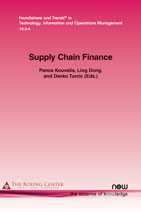Debt Financing and Supply Chain Capacity Investment
By Qiaohai (Joice) Hu, University of Missouri St. Louis, USA, joice.hu@gmail.com
Abstract
This paper studies a supply chain composed of a supplier and a buyer. The supplier has to make a buyer-specific capacity investment before demand uncertainty has been resolved. After the uncertainty has been revealed, the firms decide whether to trade with each other and on what terms through bilateral bargaining. I show that the supplier will borrow risky debt and invest more in capacity than if it Ire purely equity financed. The expanded capacity under risky borrowing is below the channel-efficient level if it is optimal to finance capacity investment with a mixture of equity and debt, and above the channel-efficient level if it is optimal to finance capacity investment entirely with debt.
Supply Chain Finance
Supply Chain Finance focuses is on creating liquidity in the supply chain through various Buyer or Seller-led solutions with or without a facilitating technology. The role of supply chain finance (SCF) is to optimize both the availability and cost of capital within a given buyer-supplier supply chain. To add further value, information on the physical flow of goods can be monitored. The coupling of information enables lenders to mitigate financial risk within the supply chain. The mitigation of risk allows more capital to be raised, capital to be accessed sooner, or capital to be raised at lower rates. Supply chain participants reside in diverse economic environments, are of different sizes, face a variety of uncertainties, have different bargaining powers over its trading partners, and have different accessibilities to capital markets. Many forms of financing arrangements between buyers and suppliers have emerged intending to overcome challenges in their specific economic and business environments.
Part 1 examines Supplier Financing. The three papers included in this section discuss supplier based financing issues including: motivation and rationale for supplier based financing, the optimal mix of bank financing and supplier financing, and empirical study of the impact of trade credit on firm performance. Part 2 focuses on Buyer Financing including three papers included that discuss buyer based financing issues in supply chains including the rationales of different types of buyer based financing arrangements and their impacts on supply chain performance. Part 3 reviews Inventory Models and Financing Consideration and the two papers in this part of the book explore how to coordinate the management of the cash flow and inventory flow within an organization and the relationship between a firm’s inventory policy and its cost of capital. Part 4 examines Operational Investments and Financing Issues and includes four papers that address operational investments with explicit financing considerations.

Companion
Foundations and Trends® in Technology, Information and Operations Management, Volume 10, Issue 3-4 Special Issue: Supply Chain Finance
See the other articles that are also part of this special issue.